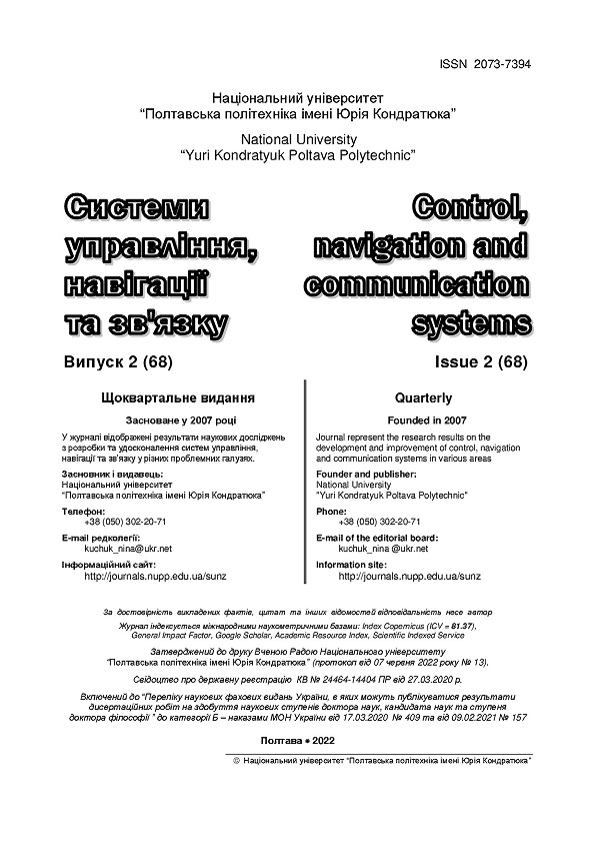APPLICATION OF UNCONDITIONAL OPTIMIZATION METHODS IN THE DEVELOPMENT OF INTEGRATED BUSINESS - MODELS OF PRODUCTION AND CONSUMPTION OF INFOCOMMUNICATIONS
DOI:
https://doi.org/10.26906/SUNZ.2022.2.015Keywords:
Quality of Service, multiservice networks, numerical optimization methods, infocommunication servicesAbstract
The subject matter of the article is information processing in the production and consumption of infocommunication services in multiservice networks. The goal of the study is to investigate the process of information processing in multiservice networks and to identify the quality class management tasks of infocommunication services production and consumption could be connected by methods of the several variable functions unconditional optimization. The tasks to be solved are: to analyze the processes of production and use of infocommunication technologies, taking into account the possibility of their optimization according to the QoS procedure; to propose a formulation of the QoS procedure optimization problem in a form suitable for solving by unconstrained optimization methods; to investigate the unconditional optimization application possibility of the methods according to the QoS procedure in the production and consumption of infocommunication services. General scientific and special methods of scientific knowledge are used. The following results were obtained: On the basis of the analysis of production processes and use of information communication services in different segments of the service market the possibilities of infocommunication services optimizing for QoS procedures were identified. The problem of optimization in multiservice networks providing QoS to be formulated as a problem of unconditional optimization of the two variables function. The possibility of applied use of methods of crazy optimization of QoS procedure is shown on the application of integral business model of convergent production and implementation of information communication services. Conclusions. The production and use of infocommunication services today is convergent. The definition of a single variable for the coordination of processes in the entire chain of production and consumption of infocommunication services on a unified criterion will support QoS convergent production and implementation of infocommunication services. Really, the analytical method is practically not implemented in multiservice networks, as it is difficult to approximate the second derivative. If a simple approximation of the first derivative is possible, use gradient methods. The simplest to implement method is considered to be the method of fragmentation of the step. The definition of optimization paths by the QoS procedure will provide in the multiservice networks in the field of state regulation the necessary reliability, security and efficiency, in particular by optimizing the time of packets.Downloads
References
TMN and network maintenance: international transmission systems, telephone circuits, telegraphy, facsimile and leased circuits: M.3050.3, (2005), International Telecommunication Union, Geneva, CH.
Pragyansmita, Paul and S. V. Raghavan, S. V. (2002) [On-line], Survey of QoS routing, Proceedings of the international conference on computer communication. Vol. 15, no. 1. ‒ Paghavan Survey of QoS Routing. ‒ URL: http://citeseer.ist.psu.edu/544755 .
Muller, Peter Tang, Seok-Yee and Sharif, Hamid (2010), [On-line], WiMAX Security and Quality of Service. An End-to- End Perspective, John Wiley & Sons Ltd, New York, NY. ‒ URL: https://books.academic.ru/book.nsf/88050878/WiMAX+Security+and+Quality+of+Service.+An+End-to-End+Perspective.
Kraskevich, V. Ye., Zelenskiy, K. KH. and Grechko, V. I. (1986), Chislennyye metody v inzhenernykh issledovaniyakh [Numerical Methods in Engineering Research], Vyshcha shkola, Kyyiv, SU.
Himmelblau, David M. (1975), Prikladnoye Nelineynoye programmirovaniye [Applied nonlinear programming], Translated by Bykhovskiy, M. L. (ed.), ] Mir, Moscow, SU.
Kuzovkova, T. A. (2014), [On-line], “Transformation of the model for production and consumption of infocommunication services”, T-Comm, no. 7, vol. 8, pp. 54-56.
Kuchuk, G. (2004), “Network traffic control method of a distributed control system”, Aviatsionno-kosmicheskaya tekhnika i tekhnologiya, no. 7, pp. 206–209.
Donets V., Kuchuk N., Shmatkov S. Development of software of e-learning information system synthesis modeling process. Сучасні інформаційні системи. 2018. Т. 2, № 2. С. 117–121. DOI: https://doi.org/10.20998/2522-9052.2018.2.20.
Pol'shchikov, K.A. (2012), “Method of neuro-fuzzy control of the intensity of sending data by source nodes in a specialpurpose mobile radio network”, Nauka i tekhnika povitryanykh syl Zbroynykh Syl Ukrayiny, Kharkiv: KHUPS, no 3(9), pp. 118 – 122.




